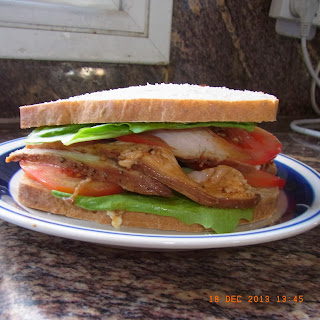I bought this pot a long time ago in the market and have never used it. It is marketed as a pot to be used for making Jachnoon - a Yemenite bread that is slooow baked overnight after being spread very liberally with butter. Put it in the oven an a low heat, say 150 F, and just leave it there for 10-12 hours! I have never made it, but I have eaten it, and it IS delicious but very different from any other bread I have eaten. Soft, and buttery, of course, but also flaky and rich. It is usually served with soft cheeses and grated (yes, grated) tomatoes spread over. Or Jam.
All this is a way of introducing my baking pot for this week's bread. I have read about Jim Lahey's no-knead technique for bread and am fascinated because it seems to fly in the face of everything we know about bread baking. Long slow rises, with virtually no kneading and then baked in a pot, covered, at high heat (425 F)! This bread is adapted from a cookbook I have by Nancy Baggett: Kneadlessly Simple:Fabulous, Fuss-Free No-Knead Breads, a great addition to anyone's cookbook collection and a nice gift for the baker in your family (or you!).
I was intrigued by the techniques she uses and wanted to try them myself. The bread, because it is baked in a closed pot, is literally steamed, and therefore develops a lovely crisp crust. The crumb is full of nice big holes and, the bottom line, it tastes great. Eat this one for breakfast with cheese or jam. Definitely worth the effort.
Here's What You'll Need:
3 tablespoons cracked wheat (or chopped wheat berries; see Tip)
2½ tablespoons flax seeds, preferably golden*
2/3 cup boiling water
2½ cups (12.5 ounces) whole wheat flour, plus more as needed
2 cups (10 ounces) unbleached white bread flour
2 tablespoons wheat germ
2 tablespoons poppy seeds
2 tablespoons sesame seeds
Generous 2¼ teaspoons table salt
1¼ teaspoons instant, fast-rising, or bread machine yeast
2½ tablespoons clover honey or other mild honey
2¼ cups ice water, plus more if needed
Corn oil, canola oil, or other flavorless vegetable oil for coating dough top and pot
2 tablespoons liquid egg substitute or egg white for glaze
1½ tablespoons each flax seeds, poppy seeds, and sesame seeds mixed together for garnish
* I used ground flax seeds because that's what I had on hand. In retrospect I think whole seeds would be better as they would not color the dough. A matter of aesthetics, I guess.
Here's What You'll Need To Do:
1. In a small bowl, combine the cracked wheat, flax seeds and boiling water. Mix then let it cool down completely.
2. In another bowl mix the dry ingredients, the flours, what germ, seeds, salt and yeast.
3. In yet another bowl mix the honey into the ice water. Then...
4. Make a well in the dry ingredients and mix in the honey ice water mixture and the cracked wheat flax seed mixture. Stir to combine and make a shaggy dough, scraping down the sides of the bowl. You may have to add a bit of water (the whole grain and the seeds absorb more water) if it is too dry. Cover and let it rest and rise for anywhere from 3 to 10 hours, or even overnight. If overnight, place the bowl in the refrigerator.
5. The next morning, if you refrigerated the dough, let it stand for at least an hour before continuing so it comes to room temperature. Then, using a well-oiled spatula, pull the dough away from the sides of the bowl and towards the center. Oil and flour your baking pot* and invert the dough into the pot, so it forms a rounded mound in the pot. Spray lightly with oil then cover and let it rise a second time, for about 2 hours or until doubled in volume.
6. Preheat the oven to 475 F (240 C). A hot oven. Place the pot, still covered, in the oven, reducing the temperature to 425 F (210 C). Bake for about 45 minutes until lightly browned. Then uncover the pot and let it bake for an additional 10 minutes or so until it is dark brown.
7. Remove the pot to a cooling rack, and let the bread cool for 15 minutes before removing it. Then, let it cool completely on the rack before slicing. This is a lovely bread for breakfast or as a snack. And, yes, this method definitely is worth trying again and again. It is less intensive than traditional methods and produces very tasty, attractive bread.
* I bought a simple aluminum pot about 8 in. diameter and 5 in. high with a close fitting lid.

















































